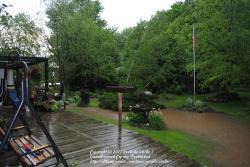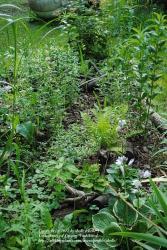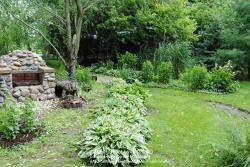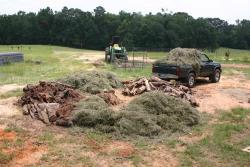I first used this method 4 or 5 years ago. I needed to construct a raised area to turn a troublesome spot into a usable one. It needed something a bit out of the ordinary to keep soil, leaves, compost and plants from washing away in spring run-off.

I began by piling logs and branches in the areas that needed to be raised, while leaving an opening for the water to make its way through to the lake. I angled the sides to direct the water flow so that I didn't end up with more pooled water in the yard than I had before.
Then I filled those areas with dirty fill. Inexpensive, even when purchased in large quantities; leaves, hay, twigs, horse manure and more soil to finish the top layer. This project was all done in summer, and by hand with a wheelbarrow since driving a vehicle into this area was out of the question. That autumn we planted tulips and a few divided perennials into the area - ones that were expendable since I had no idea what to expect.
Everything has stayed where I put it; nothing has washed away since constructing these beds, the plants have all grow wonderfully, and this is the last area on our property to receive supplemental late-summer water; it just doesn't seem to need it.




I add small logs into the beds whenever I add a plant, fallen twigs and leaves gathered from the yard, and stalks of otherwise healthy, frost-killed plants in the fall to keep the organic matter high. I haven't had to do anything further to keep it growing well; not yet, anyway.

My beds didn't retain a lot of height once things settled in, so I'll build them a bit higher next time.




